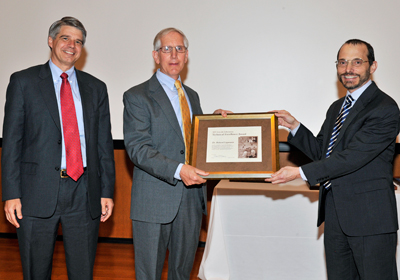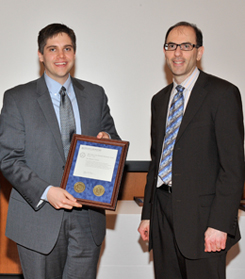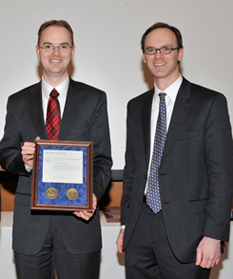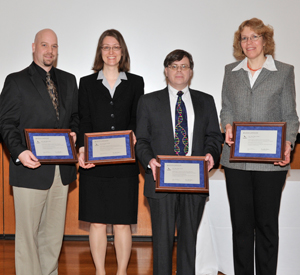News
2011 MIT Lincoln Laboratory Technical Awards are presented
at February ceremony
Richard Lippmann and Gary Hatke receive Technical Excellence Awards
On February 17 at an afternoon ceremony, MIT Lincoln Laboratory's awards for technical excellence, early career technical achievement, best paper, and best invention were presented to the 2011 recipients. Dr. Richard P. Lippmann, senior staff member in the Laboratory's Cyber Systems and Technology Group, and Dr. Gary F. Hatke, leader of the Advanced Sensor Techniques Group, received MIT Lincoln Laboratory Technical Excellence Awards. Dr. Eric D. Evans, director of the Laboratory, presented these distinguished awards recognizing exceptional, sustained, technical work that has made a significant impact on a Laboratory mission area.
 Dr. Eric Evans, director (left), presented Dr. Richard Lippmann (center) with a 2011 Technical Excellence Award. Lippmann and Dr. Marc Zissman, assistant head of the Communication Systems and Cyber Security Division, hold the award plaque. Zissman introduced Lippmann at the ceremony. Dr. Eric Evans, director (left), presented Dr. Richard Lippmann (center) with a 2011 Technical Excellence Award. Lippmann and Dr. Marc Zissman, assistant head of the Communication Systems and Cyber Security Division, hold the award plaque. Zissman introduced Lippmann at the ceremony. |
Lippmann was honored for "nationally recognized leadership in developing cyber security tools and techniques, contributions to the field of speech recognition, and international leadership in neural networks and pattern classification." At Lincoln Laboratory, he pioneered research in the cyber field, directing the first careful and systematic evaluations of intrusion detection systems for the Defense Advanced Research Projects Agency (DARPA). He also worked on speech recognition technologies, developing word recognizers and word-spotting systems.
 Dr. Gary Hatke (center) was presented with a 2011 Technical Excellence Award by Dr. Eric Evans, director (left), and was introduced by Dr. James Ward (right), assistant head of the ISR and Tactical Systems Division. Dr. Gary Hatke (center) was presented with a 2011 Technical Excellence Award by Dr. Eric Evans, director (left), and was introduced by Dr. James Ward (right), assistant head of the ISR and Tactical Systems Division. |
Hatke was recognized for "contributions in the development of direction finding for radar guided missiles, ground-based and airborne signals intelligence, robust GPS navigation, counter–improvised explosive device systems, and special communications." He has worked on adaptive array processing systems and space-time adaptive beamforming systems for anti-jam applications for GPS adaptive antenna arrays. As a group leader, he provides technical guidance in many areas, including distributed sensing, look-down antenna array systems for target geolocation, and advanced multiple-input, multiple-output communications.
Michael T. Boulet, a technical staff member in the Control Systems Engineering Group, and Dr. Mykel J. Kochenderfer, a technical staff member in the Surveillance Systems Group, received Early Career Technical Achievement Awards. Dr. Eliahu H. Niewood, head of the Engineering Division, presented the award to Boulet for his technical abilities and vision. Boulet designed a coherent strategy for the Laboratory's autonomous systems effort and provides technical support to important communications programs. Dr. James K. Kuchar, leader of the Weather Sensing Group, presented Kochenderfer with the award recognizing his development of a new collision avoidance system and advanced techniques for air traffic control systems.
 |
 |
| Early Career Technical Achievement Awards for 2011 were presented to Michael Boulet (left, left photo), who is shown with Dr. Eliahu Niewood, and to Dr. Mykel Kochenderfer (left, right photo), shown withDr. James Kuchar.
|
|
 |
The 2011 MIT Lincoln Laboratory Best Paper Award was presented by Dr. Eric Evans to the authors of “Broad-Spectrum Antiviral Therapeutics,” published in PLoS ONE in July 2011. Seen here with their commemorative plaques are authors Scott T. Wick, Tara L. Boettcher, Dr. Todd H. Rider, and Christina Postema-Zook.
|
 |
The 2011 MIT Lincoln Laboratory Best Invention Award trophies were presented to (left to right) Drs. Antonio Sanchez-Rubio, Bien Chann, and Tso Yee Fan for “External-Cavity One-Dimensional Multi-wavelength Beam Combining of Two-Dimensional Laser Elements,” which was granted a U.S. patent in November 2011. |
Lincoln Laboratory established the Technical Excellence Awards in 2001 to recognize exceptional individual technical accomplishments that significantly contributed to a Laboratory mission area. In addition to their awards, recipients are honored with the inclusion of their names on a permanent plaque at the Laboratory. The Best Paper and Best Invention Awards were introduced in 2009, and the Early Career Technical Achievement Awards were instituted in 2010.
Posted March 2012
top of page